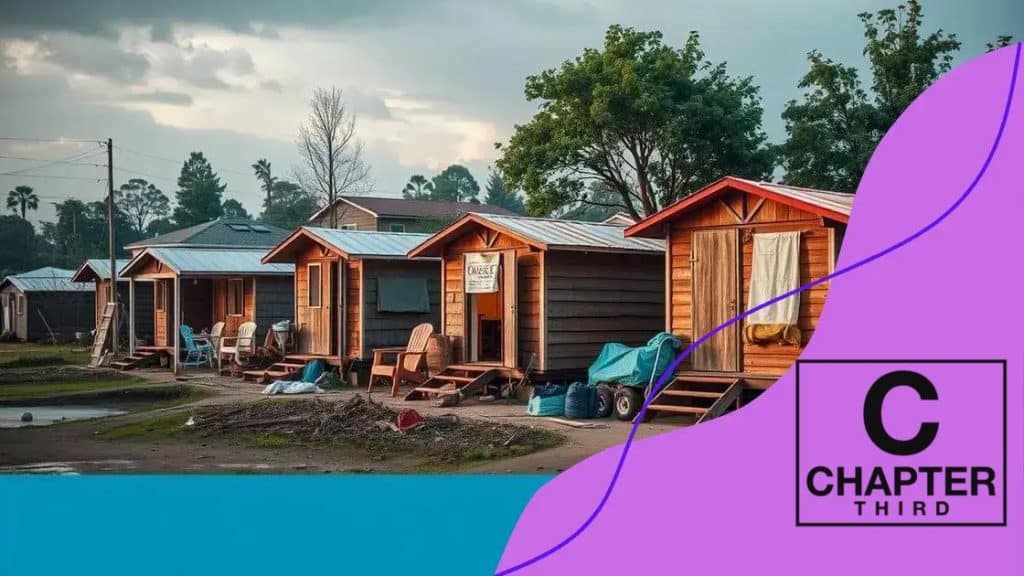Emergency housing aid after climate disasters

Emergency housing aid after climate disasters involves timely logistical support, innovative housing solutions, community participation, and strategic partnerships to effectively respond to the needs of displaced populations.
Emergency housing aid after climate disasters plays a crucial role in helping communities recover swiftly. Have you ever thought about how such aid changes lives? Let’s delve into the various dimensions of this critical support.
Understanding emergency housing needs
Understanding the emergency housing needs after a climate disaster is essential for effective recovery strategies. When a natural disaster strikes, many families lose their homes in an instant. This makes rapid assessment of housing needs crucial to address the immediate challenges faced by affected communities.
Key Factors in Housing Needs
There are several key factors that contribute to the housing needs of communities after a disaster. These include:
- The extent of damage to existing homes.
- The number of displaced families and individuals.
- Access to essential services and infrastructure.
- The timeframe for recovery and rebuilding.
Another important aspect is the unique requirements of different populations. For example, elderly individuals and those with disabilities may need specific accommodations. Recognizing these nuances allows for more tailored solutions. It’s also vital to keep in mind that traditional housing options may not be feasible in all situations.
Community Involvement
Engaging the community in the recovery process can significantly enhance the response efforts. Local knowledge often provides valuable insights into housing needs. Collaboration among local authorities, non-profits, and community organizations can streamline resource distribution and support systems.
Furthermore, having a well-established communication network can help in disseminating information about available housing options and resources. This kind of proactive approach can alleviate uncertainty and fear among those displaced by disasters.
Ultimately, understanding emergency housing needs is not only about providing shelter but ensuring that these solutions are sustainable and meet the long-term aspirations of affected communities.
The role of government in providing aid
The role of government in providing aid during emergencies cannot be overstated. When disasters occur, especially those related to climate change, governments are often the first line of defense. They are responsible for assessing damage and mobilizing resources to support affected communities.
Coordinating Relief Efforts
One crucial aspect of government involvement is coordinating relief efforts among various agencies and organizations. This ensures that assistance is timely and effective. Local governments work with federal and state agencies to:
- Implement response strategies quickly.
- Ensure that necessary supplies reach those in need.
- Provide information to the public about available resources.
In addition to logistics, understanding the specific needs of the affected population is vital. By gathering data on the extent of the damage and the demographics of the affected areas, governments can tailor their responses accordingly.
Financial Support and Resources
Governments often allocate emergency funds to support recovery efforts. These funds can be used for immediate assistance, such as temporary housing and food, as well as long-term recovery projects. For example, they might invest in rebuilding homes to ensure they are more resilient against future disasters.
Moreover, establishing partnerships with non-profit organizations can enhance the effectiveness of government aid. These collaborations can help bridge funding gaps and provide specialized services that a government may not be able to offer alone.
Overall, the government’s ability to effectively engage in providing aid makes a significant difference in the recovery of communities affected by climate-related disasters. This commitment to support can speed up a community’s return to normalcy.
Innovative solutions for rapid housing

Innovative solutions for rapid housing are essential in responding to emergencies caused by climate disasters. When homes are lost, communities need quick and effective alternatives to restore their living conditions. Creative approaches can significantly speed up the housing recovery process.
Temporary Housing Solutions
Temporary housing, such as modular units and tents, can be set up quickly to provide shelter for displaced families. These solutions are often customizable and can be deployed in various settings. Additionally, advancements in technology allow for:
- 3D-printed homes that can be constructed in days.
- Prefabricated structures that are easy to transport and assemble.
- Smart housing solutions that integrate renewable energy sources.
These options not only provide immediate relief but can also be designed for long-term use, which helps communities adapt to future challenges.
Community-Based Initiatives
Community-based solutions are also pivotal. Local governments and organizations can come together to create innovative housing solutions that reflect the unique needs of their populations. Involving community members in the planning process ensures that the solutions are culturally appropriate and effective.
Additionally, utilizing local resources can make rebuilding more sustainable. For example, salvaged materials from previous homes can be repurposed in new builds, minimizing waste while supporting local economies. Emphasizing sustainability in construction practices can lead to a more resilient infrastructure.
By focusing on innovative solutions, communities can build back better and create housing that withstands future climate-related challenges.
Challenges in delivering emergency housing
Delivering emergency housing during a crisis presents significant challenges. Various factors can complicate the process, delaying vital assistance to affected families. Understanding these challenges is crucial for improving future responses.
Logistical Issues
One major challenge is logistical constraints. Getting supplies and housing units to disaster zones can be tough. These areas might have damaged roads or disrupted transportation systems. Additionally, fluctuating weather conditions can hinder timely delivery.
- Limited access to remote areas.
- Inconsistent communication networks.
- Insufficient transportation resources.
These factors can create delays and increase stress for those in need. Collaboration among various agencies can help address these issues, ensuring more efficient logistics.
Funding and Resource Allocation
Another significant obstacle is securing adequate funding. Emergency housing programs need immediate financial support to function effectively. Without enough resources, organizations may struggle to provide necessary services. This includes:
- Purchasing temporary housing materials.
- Hiring qualified personnel to assist with logistics and setup.
- Providing ongoing support services for displaced individuals.
Resource allocation must be managed wisely to avoid waste, ensuring every dollar contributes to rebuilding lives. Lack of clear government funding and support can exacerbate these issues.
Communication among stakeholders is vital to overcome these hurdles. Effective coordination helps streamline processes, making it easier to provide swift assistance to those who need it most. By addressing these challenges head-on, the goal is to develop more resilient and efficient systems for delivering emergency housing.
Case studies of successful aid initiatives
Case studies of successful aid initiatives provide valuable insights into effective recovery strategies after climate disasters. By examining these examples, we can identify best practices and innovative solutions that worked in real-life scenarios.
The Role of Community Engagement
In many cases, successful initiatives have involved strong community engagement. For instance, in the aftermath of Hurricane Katrina, community organizations played a key role in mobilizing volunteers and resources. They engaged residents in rebuilding efforts, ensuring that the solutions met local needs.
- Collaborative planning with community members.
- Utilizing local resources and materials.
- Providing training for residents to take part in construction efforts.
This approach not only fostered a sense of ownership among residents but also helped expedite the recovery process.
Innovations in Housing Solutions
Another successful initiative was the adoption of innovative housing solutions in response to the 2010 earthquake in Haiti. Organizations implemented temporary shelters that could be quickly assembled and adapted based on available materials. By using local resources, they created sustainable housing options that integrated well with the local environment.
Adaptable designs became crucial, allowing families to expand or modify their shelters as resources became available. This helped communities recover more effectively while also reducing waste.
Partnerships and Funding
Successful aid initiatives often rely on strategic partnerships. For example, after the earthquake in Nepal, a collaboration between the government, local NGOs, and international agencies resulted in a cohesive recovery strategy. They pooled resources to establish a comprehensive support system that included:
- Financial assistance for rebuilding.
- Access to training for sustainable building practices.
- Long-term planning for disaster resilience.
These partnerships not only improved the immediate response but also laid the groundwork for a more resilient community.
Conclusion:
In summary, exploring successful aid initiatives reveals key insights into how communities can effectively respond to climate disasters. By focusing on community engagement, innovative housing solutions, and strategic partnerships, we can create a solid framework for disaster recovery. These approaches not only help provide immediate assistance but also empower communities to build back better and become more resilient in the face of future challenges.
Here’s a brief summary of the key points:
FAQ – Emergency Housing Aid After Climate Disasters
What are the key factors in delivering emergency housing?
Key factors include logistical challenges, adequate funding, community engagement, and timely response efforts.
How does community involvement improve recovery efforts?
Community involvement ensures that recovery efforts reflect local needs and fosters a sense of ownership among residents.
What innovative solutions are being used for emergency housing?
Innovative solutions include modular units, 3D-printed homes, and adaptive temporary shelters that can be quickly assembled.
Why are partnerships important in disaster recovery?
Partnerships bring together resources and expertise from various organizations, enhancing the overall effectiveness of recovery initiatives.





